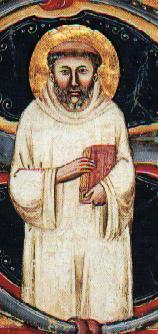



|

|

|
Contrapunctus XIX
|
By David R. Graham
The Knights Templar ...
On the Importance of Nothing
The key to understanding the Templars (Knights Templar, Knights of the Temple of Jerusalem [= My God is the Sun/Peace]) is their primary colors, white and red, purity and passion, or better, red on white, passion on purity:
Regarding the First Millennium: The Templars represent Christianity. The Bishops of Rome and Constantinople represent Imperialism. The Normans represent Leadership. Significantly, Templars, Norman Conquest and East-West Bishops' Condemnation occur at the same moment. The true and the anti-true emerge simultaneously. The Bishops of Rome and Constantinople were right to condemn one another for heresy, which, in simplest terms, is any representation of a part of something as the whole of it. Neither of these Bishops excommunicated the Dali Lama so that leader is the current head of the Christian Church. The red cross of the Templars indicates the essence of the human and, therefore, the essence of religion, including Christianity, namely, passion, blood. The colors of Christianity are white for purity and red for passion. To these may be added trim colors of blue for water or green for leaves -- food (tangible) elements. However, Christianity is represented by red for passion and white for purity -- soul (intangible) elements. These are non-worldly colors meant to indicate an ultimate concern that is not of this world but is practiced by means of it. Red and white announce an ambition for transcendence of this world by means of this world to the perpetual, the sweet and the beautiful (Sathyam, Sivam, Sundaram). The colors of the Bishop of Rome are yellow, purple and blue. These are royal (purple, blue) and imperial (yellow) colors meant to indicate worldly prestige and glory. This Bishop's colors announce an ambition for the vicissitudes as well as the rewards of international hegemony in all areas of endeavour. The Roman Catholic Church (The Vatican) is an anachronism, an assertion of global hegemony for a Roman Emperium expanded by an appropriation of concepts from Tibetan feudal religion, which contemplated hegemony inside Tibet but not outside it, and the application of those concepts by the Vatican's feudal representatives to all areas of the globe. The Vatican, alone among all institutions of man, excepting the Communist Party, asserts unilateral world legitimacy and therefore hegemony for its wishes. (Note on 20 November 2004: the last sentence above is not precisely true. Iranian and Wahabi clerics, although not precisely institutions, do assert unilateral world legitimacy and therefore hegemony for their wishes.) The Dalai Lama claimed hegemony inside Tibet. The Bishop of Rome claimed hegemony inside the world. The Vatican does not see nations. It sees feudal religion -- defined as itself -- controlling everything, tangible and intangible. The Roman Catholic Church or Vatican is not a Christian institution, as the Reformers declared, and its Bishop and College of Cardinals represent themselves, not Christianity. The Bishop of Rome was excommunicated, as was the Bishop of Constantinople, at the turning of the second Christian Millennium. Those excommunications were warranted and effective and they are still in effect. The Bishop of the Church is the Bishop of Milan, at the Celto-Roman Cathedra of Ambrose. The Bishop of Milan represents Christianity, preeminently among all other Bishops of the Church. The Bishop of Milan is the Bishop of Rome as meant by "et ego dico tibi quia tu es Petrus et super hanc petram aedificabo ecclesiam meam et portae inferi non praevalebunt adversum eam" (Matthew 16:18). After Gregory I, the Bishops of Rome were of Mongoloid/Pan-Slavic wishes and the Vatican emerged from these absolutists, later called Guelfs. The Templars "spit on the [yellow/bronze] cross." That is, they spit on the cross of the Bishop of Rome. Their intention was to show disrespect, as due the perfidious. The true cross is red, the color of blood, from the blood of Jesus, who died on a cross. The true cross symbolizes not grandeur and glory (yellow) but passion and loss through voluntary renunciation (red). Templars were known to make this point poignantly, by spitting on the yellow (Papal) cross, which communicates a prestige Christianity shuns as unhuman and inhuman. The "treasure" Templars recovered beneath the Temple of Solomon was the skull of Jesus. This relic was and is the source of the "wealth" of the Templars. It is in Switzerland at the moment, having been at Chartres and Nantes and several other places. The main burial of Jesus was at Sri Nagar but portions of his remains were transferred back to Jerusalem during the so-called Dark Ages. This activity, and the need to extend it by removing the remains further west, was the substance of the Calabrian (Benedictine) mission to Lorraine that resulted in the formation and deployment of the Knights Templar. The Knights of the Temple (Knights Templar) are synonymous with Christianity. They are a monastic military order having the mission of protecting Christianity by protecting its principle relic. The sacred texts of Christianity are in Russia at the moment, from where next comes He who inspires them. Christianity is based on the Seers of Buddhism, principally Tibetan, with whom Jesus lived for many years. The "Three Wise Men" were Tibetans. Christianity is not a "Semitic religion." That phrase is an oxymoron. Christianity is a universal religion, the only kind there is, and not an hegemonistic one, not even in a bounded territory. |
The pictures at the top of this page represent
Saint Bernard of Clairvaux,
the Mellifluous Doctor.
Contrapuncti
Phenomena to Study (U.S.A.)
Phenomena to Study (Poland)